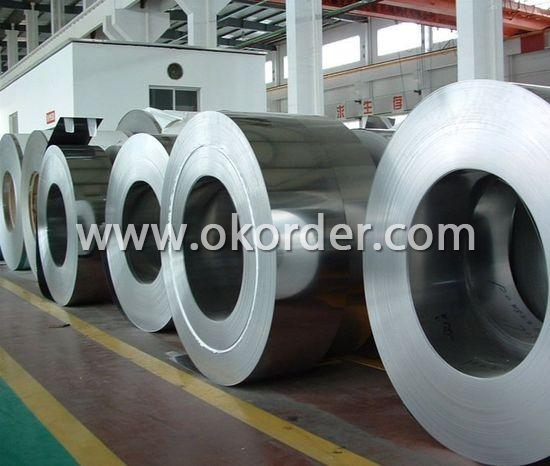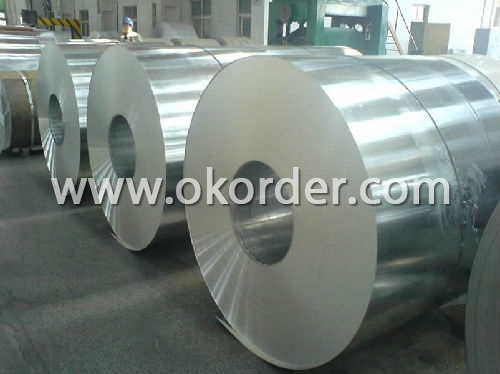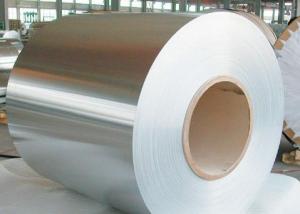AISI 304 Stainless Steel Coil
- Loading Port:
- China Main Port
- Payment Terms:
- TT or LC
- Min Order Qty:
- 1 Ton m.t.
- Supply Capability:
- 1000 Tons Per Month m.t./month
OKorder Service Pledge
OKorder Financial Service
You Might Also Like
AISI 304 Stainless Steel Coil
1. Chemical composition of AISI 304 Stainless Steel Coil
C | Si | Mn | P | S | Ni | Cr |
max0.08 | max1.00 | max2.00 | max0.045 | max0.03 | 8.00-10.50 | 18.00-20.00 |
2. Mechanical properties of AISI 304 Stainless Steel Coil
Yield Strength | Tensile | Elongation | Hardness (HV) | Hardness (HRB) |
≥ 205 | ≥ 520 | ≥ 40 | ≤ 200 | ≤ 90 |
3. Standard of AISI 304 Stainless Steel Coil : AISI, ASTM, GB, EN, DIN, JIS
4. Surface of AISI 304 Stainless Steel Coil : 2B, NO.1, BA, NO.4, Hairline, SB, Mirror finish, Anti-skid, Cherkered etc.
5. Size of AISI 304 Stainless Steel Coil :
Thickness: 0.3-3mm (cold rolled), 3-40mm (hot rolled)
Width: 1000mm or 1219mm or 1240mm for cold rolled, 1500mm for hot rolled.
Length: As customers' request.
6. MOQ of AISI 304 Stainless Steel Coil : 1 Ton
7. Payment terms of AISI 304 Stainless Steel Coil : T/T or L/C
8. Packing of AISI 304 Stainless Steel Coil : Seaworthy package with wooden or Iron pallets with the paper and the steel strip,
or as customers' request.
9. Delivery time of AISI 304 Stainless Steel Coil : Usually about 7 days after we confirming the order, or according to your quantity.
If you have any demand, pls feel free to contact me.


- Q:Can stainless steel strips be used in the automotive industry?
- The automotive industry can make use of stainless steel strips, which are versatile and durable. Stainless steel is a material that offers numerous advantages for automotive applications. It possesses excellent corrosion resistance, making it capable of withstanding harsh environmental conditions and exposure to road salts or chemicals. Moreover, stainless steel strips are resistant to heat and can endure high temperatures, making them suitable for various automotive components like exhaust systems and engine parts. Additionally, they possess high strength and can provide structural support and reinforcement for automotive frames and body panels. Furthermore, they can be utilized for decorative purposes, enhancing the aesthetic appeal of vehicles. All in all, stainless steel strips are a dependable and valuable material choice for the automotive industry.
- Q:Are 111 stainless steel strips suitable for wastewater treatment plants?
- Yes, 111 stainless steel strips are suitable for wastewater treatment plants. Stainless steel is highly resistant to corrosion, which makes it an ideal material for environments with high moisture and chemical exposure like wastewater treatment plants. Additionally, 111 stainless steel strips offer good strength and durability, ensuring they can withstand the harsh conditions and demands of wastewater treatment processes.
- Q:What is the electrical conductivity of stainless steel strips?
- The electrical conductivity of stainless steel strips can vary depending on the specific type and composition of stainless steel. Generally, stainless steel is not as conductive as other metals like copper or aluminum. The electrical conductivity of stainless steel is typically lower due to its higher resistance to the flow of electric current. However, there are stainless steel alloys that have been specifically designed for improved electrical conductivity. These alloys often contain higher levels of elements like nickel or copper, which enhance the material's conductivity. It is important to note that the electrical conductivity of stainless steel can also be affected by factors such as temperature, surface condition, and thickness of the strip. Therefore, it is advisable to refer to specific data or consult with manufacturers for accurate information on the electrical conductivity of stainless steel strips.
- Q:Can stainless steel strips be used in food processing industries?
- Yes, stainless steel strips can be used in food processing industries. Stainless steel is highly resistant to corrosion, easy to clean, and has excellent hygiene properties, making it a preferred choice for equipment, machinery, and surfaces in food processing facilities.
- Q:How do stainless steel strips resist stress corrosion cracking in chloride environments?
- Stainless steel strips are highly resistant to stress corrosion cracking in chloride environments due to their inherent properties and specific alloy composition. The primary factors that contribute to this resistance include the presence of chromium, molybdenum, and nickel in the stainless steel alloy. Chromium is the main component responsible for the corrosion resistance of stainless steel. When exposed to chloride ions in the environment, a passive oxide layer of chromium oxide forms on the surface of the stainless steel strips. This oxide layer acts as a protective barrier, preventing the penetration of chloride ions and reducing the likelihood of stress corrosion cracking. Molybdenum is another crucial element in stainless steel alloys that enhances their resistance to stress corrosion cracking in chloride environments. It provides additional protection by increasing the material's resistance to pitting and crevice corrosion, which can be precursors to stress corrosion cracking. The presence of molybdenum also improves the overall strength and durability of the stainless steel strips. Nickel is an alloying element that further enhances the resistance of stainless steel strips to stress corrosion cracking. It increases the material's ability to withstand the corrosive effects of chloride ions, thereby minimizing the risk of crack initiation and propagation. In addition to these alloying elements, the specific composition and microstructure of the stainless steel strips play a crucial role in their resistance to stress corrosion cracking. The selection of an appropriate stainless steel grade, such as 316 or 904L, with a higher content of chromium, molybdenum, and nickel, ensures optimal resistance to chloride-induced corrosion. Furthermore, proper fabrication processes and surface treatments, such as passivation, can help enhance the corrosion resistance of stainless steel strips in chloride environments. Passivation involves the removal of iron contaminants from the surface and the formation of a more uniform and protective chromium oxide layer, further reducing the risk of stress corrosion cracking. Overall, stainless steel strips resist stress corrosion cracking in chloride environments due to the synergistic effects of chromium, molybdenum, and nickel, as well as their specific alloy composition, microstructure, and surface treatments. These factors collectively contribute to the exceptional corrosion resistance of stainless steel, making it a preferred choice for various industries, including marine, chemical, and oil and gas.
- Q:Are stainless steel strips suitable for outdoor signage?
- Stainless steel strips are indeed a great option for outdoor signage. This material is not only durable and resistant to corrosion, but it is also perfect for outdoor use. It can endure a wide range of weather conditions, such as rain, snow, and sunlight, without succumbing to rust or deterioration. Moreover, stainless steel has a modern and sleek appearance that can greatly enhance the visual appeal of outdoor signage. Additionally, it is highly resistant to impact, which means it will last for a long time and require minimal maintenance. In conclusion, stainless steel strips are a dependable and suitable choice for outdoor signage because they are durable, weather-resistant, and visually appealing.
- Q:What are the standard coil sizes for stainless steel strips?
- The standard coil sizes for stainless steel strips typically range from 0.25 inches to 12 inches in width and 0.020 inches to 0.125 inches in thickness. However, these sizes can vary depending on the specific manufacturer and customer requirements.
- Q:What is the hardness of stainless steel strips?
- The hardness of stainless steel strips can differ based on various factors, including the specific grade of stainless steel, the applied heat treatment, and the method of manufacturing. Stainless steel is generally recognized for its hardness and strength, but different grades offer varying levels of hardness. Stainless steel strips are commonly produced in grades like 304, 316, 430, and 201, among others. These grades possess different compositions and properties that directly impact their hardness. Typically, stainless steel strips are hardened through cold rolling, a process that involves compressing and stretching the material to enhance its hardness and strength. To measure the hardness of stainless steel strips, the Rockwell scale is commonly used. This scale offers a standardized method for determining the material's resistance to indentation. The typical hardness values for stainless steel strips can range from approximately 70 HRB (Rockwell B scale) for softer grades to over 90 HRB for harder grades. It's worth noting that the hardness of stainless steel strips can also be further adjusted through additional heat treatment processes, such as annealing or tempering. These processes can either increase or decrease the material's hardness, depending on the desired characteristics and application requirements. In conclusion, the hardness of stainless steel strips can vary significantly depending on the specific grade, heat treatment, and manufacturing process. To determine the exact hardness for a particular application, it's essential to consult the material's technical specifications or seek advice from a metallurgical expert.
- Q:Can 111 stainless steel strips be perforated for filtration applications?
- Yes, 111 stainless steel strips can be perforated for filtration applications.
- Q:Can stainless steel strips be used in the medical implants?
- Yes, stainless steel strips can be used in medical implants. Stainless steel is often chosen for medical implants due to its high strength, corrosion resistance, and biocompatibility. It is commonly used for various applications, such as orthopedic implants, surgical instruments, and cardiovascular devices.
1. Manufacturer Overview |
|
|---|---|
| Location | Guangzhou,China |
| Year Established | 2001 |
| Annual Output Value | Above US$0.5 Million |
| Main Markets | Southeast Asia, Europe |
| Company Certifications | ISO 9001:2008; |
2. Manufacturer Certificates |
|
|---|---|
| a) Certification Name | |
| Range | |
| Reference | |
| Validity Period | |
3. Manufacturer Capability |
|
|---|---|
| a)Trade Capacity | |
| Nearest Port | Shanghai |
| Export Percentage | 30% |
| No.of Employees in Trade Department | 10 People |
| Language Spoken: | English;Chinese |
| b)Factory Information | |
| Factory Size: | Above 30,000 square meters |
| No. of Production Lines | Above 7 |
| Contract Manufacturing | OEM Service Offered;Design Service Offered |
| Product Price Range | Average |
Send your message to us
AISI 304 Stainless Steel Coil
- Loading Port:
- China Main Port
- Payment Terms:
- TT or LC
- Min Order Qty:
- 1 Ton m.t.
- Supply Capability:
- 1000 Tons Per Month m.t./month
OKorder Service Pledge
OKorder Financial Service
Similar products
New products
Hot products
Related keywords





























